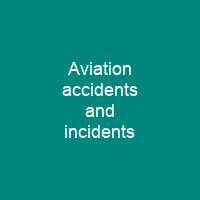Understanding the Gravity of Aviation Accidents
Imagine a world where every flight is a potential disaster waiting to happen. This stark reality has been a part of aviation history for over a century, with countless incidents and accidents marking the journey towards safer skies. An aviation accident is defined as an event causing serious injury or death during aircraft operation, while an incident compromises safety but does not progress to an accident. The Convention on International Civil Aviation Annex 13 provides a clear distinction between these terms.
The First Recorded Accidents
Our journey into the history of aviation accidents begins with the first recorded hot air balloon crash in Ireland on May 10, 1785. This event marked the beginning of a long and often tragic history. Fast forward to September 17, 1908, when Orville Wright and a passenger were injured, and another person was killed in a US crash – marking the first powered aircraft accident.
Deadliest Accidents
The deadliest aviation accidents include some of the most tragic events in history. For instance, Turkish Airlines Flight 981 (1974), which claimed 346 lives due to cargo door detachment and explosive decompression. Another chilling incident is the Japan Air Lines Flight 123 (1985), where an incorrectly repaired aft pressure bulkhead led to an explosive decompression, resulting in 520 fatalities.
The Tenerife Disaster
The Tenerife airport disaster (1977) stands out as one of the deadliest aviation accidents. A KLM Boeing 747 collided with a Pan Am 747 at Los Rodeos Airport, resulting in 583 fatalities. This tragic event highlighted the critical importance of clear communication and coordination among air traffic controllers.
The Impact on Aviation Safety
Despite these harrowing incidents, aviation safety has improved significantly over the years. Modern aircraft now come equipped with advanced avionics, turbine engines with improved durability, and landing gear that can be lowered even after loss of power and hydraulics. These innovations have made air travel much safer than it was a century ago.
Survival Rates
A study found that passengers sitting at the back of a plane are 40% more likely to survive a crash than those sitting at the front. The survival rate for people in US plane crashes between 1983 and 2000 was over 95%. This statistic underscores the importance of seat positioning during an emergency.
Global Efforts
The European Aviation Safety Agency (EASA) plays a crucial role in ensuring aviation safety. It provides annual reviews, statistics on civil aviation safety, and access to accident information collected by the International Civil Aviation Organization (ICAO). Annex 13 of ICAO sets international standards for air accident investigations.
Investigation Agencies
Air safety investigation agencies around the world work tirelessly to prevent future accidents. For instance, in Australia, the Australian Transport Safety Bureau investigates aviation accidents and incidents. In France, the Bureau d’Enquêtes et d’Analyses pour la Sécurité de l’Aviation Civile (BEA) conducts technical investigations for civil aviation accidents.
Retirement of Flight Numbers
Out of respect for the deceased and injured, it is common for airlines to cease using the flight number of a fatal crash. For example, following the shootdown of Malaysia Airlines Flight 17, the flight number was changed to MH19. However, not all airlines follow this practice; some continue using their original numbers even after tragic incidents.
Conclusion
The history of aviation accidents is a testament to both human ingenuity and vulnerability. While we have made significant strides in improving safety, the memory of those lost serves as a constant reminder of the importance of vigilance and continuous improvement. As technology advances, so too must our commitment to ensuring that every flight is not just safe but also secure.

You want to know more about Aviation accidents and incidents?
This page is based on the article Aviation accidents and incidents published in Wikipedia (retrieved on March 10, 2025) and was automatically summarized using artificial intelligence.




